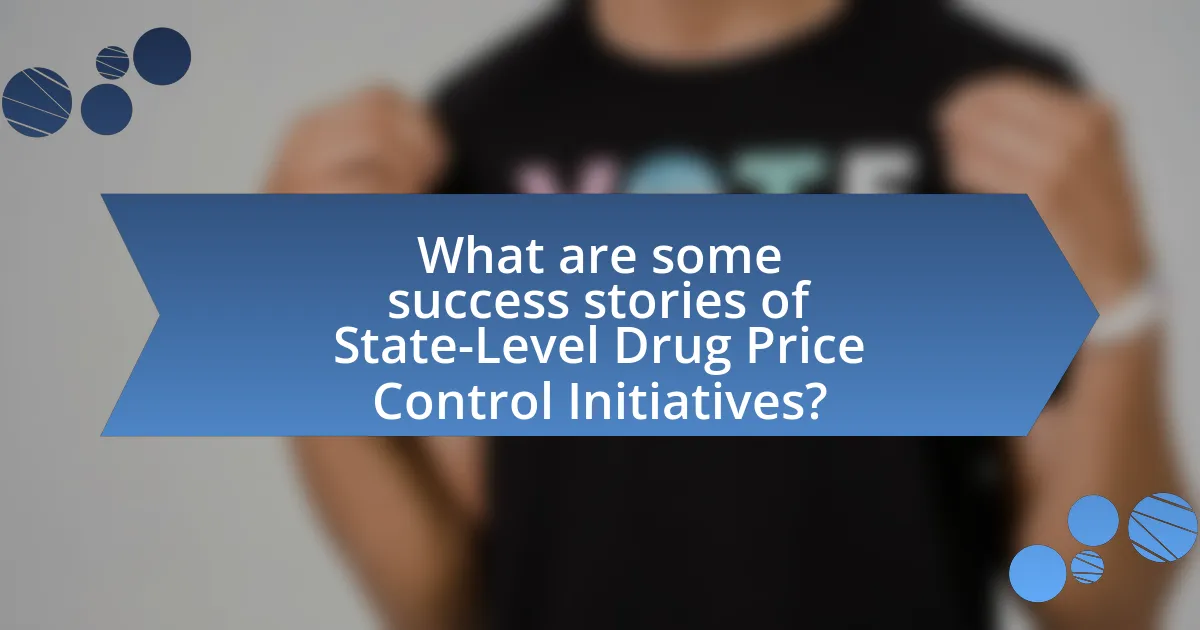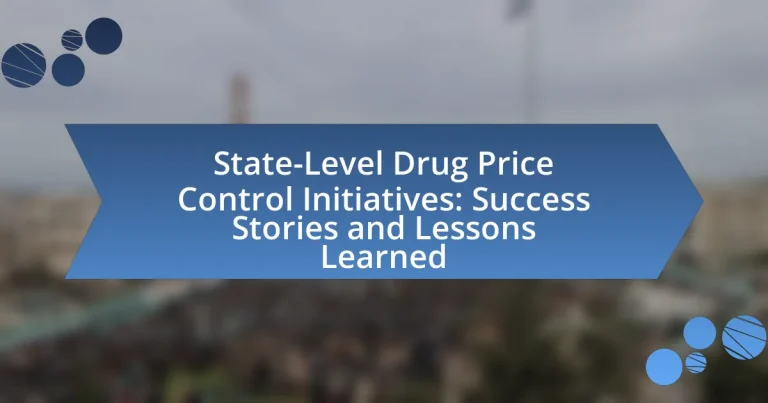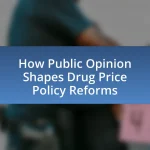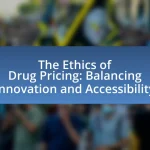State-level drug price control initiatives are programs designed to regulate and lower prescription medication costs through various mechanisms such as price negotiations, price caps, and transparency requirements. This article examines the effectiveness of these initiatives, highlighting successful examples from states like California and Vermont, which have achieved significant savings for consumers and healthcare systems. It also discusses the challenges states face in implementing these measures, the impact on healthcare costs and access to medications, and the lessons learned from successful initiatives that can inform future efforts in drug price regulation.

What are State-Level Drug Price Control Initiatives?
State-level drug price control initiatives are programs implemented by individual states to regulate and lower the prices of prescription medications. These initiatives often involve negotiating prices with pharmaceutical companies, establishing price caps, or creating public programs to provide medications at reduced costs. For example, states like California and Vermont have enacted laws that allow them to negotiate directly with drug manufacturers, aiming to reduce the financial burden on consumers and state healthcare systems. Such initiatives have been shown to lead to significant savings for both patients and state budgets, demonstrating their effectiveness in addressing high drug prices.
How do these initiatives aim to regulate drug prices?
State-level drug price control initiatives aim to regulate drug prices by implementing measures such as price caps, transparency requirements, and negotiation powers for state agencies. These initiatives often establish maximum allowable prices for certain medications, ensuring that prices remain affordable for consumers. For example, states like California and Vermont have enacted laws that require pharmaceutical companies to disclose pricing information and justify price increases, which promotes accountability and can lead to lower costs. Additionally, some states have empowered their Medicaid programs to negotiate directly with drug manufacturers, further driving down prices through competitive bidding.
What mechanisms are used in these initiatives to control prices?
State-level drug price control initiatives utilize various mechanisms to regulate and lower medication costs. These mechanisms include price negotiation with pharmaceutical companies, implementing price caps, establishing reference pricing based on prices in other countries, and promoting the use of generic drugs. For instance, states like California have enacted laws that allow state agencies to negotiate directly with drug manufacturers, which has led to significant price reductions for certain medications. Additionally, some states have adopted policies that require transparency in drug pricing, compelling manufacturers to disclose pricing information, which can further aid in controlling costs.
How do state governments implement these mechanisms?
State governments implement drug price control mechanisms through legislation, regulation, and collaboration with stakeholders. For instance, states may pass laws that establish price caps on certain medications or require transparency in drug pricing from manufacturers. Additionally, state governments often engage in negotiations with pharmaceutical companies to secure lower prices for state-funded health programs. Evidence of effectiveness can be seen in states like California and Vermont, which have enacted laws mandating price negotiations and reporting, leading to reduced costs for consumers and state health programs.
Why are State-Level Drug Price Control Initiatives important?
State-level drug price control initiatives are important because they aim to reduce the cost of prescription medications for consumers, thereby increasing access to essential treatments. These initiatives address the rising prices of pharmaceuticals, which have been shown to outpace inflation and wage growth, leading to financial strain on patients. For instance, a report from the House of Representatives in 2021 indicated that nearly one in four Americans have reported not filling a prescription due to cost concerns. By implementing price controls, states can negotiate better prices with pharmaceutical companies, ultimately lowering out-of-pocket expenses for patients and improving public health outcomes.
What impact do these initiatives have on healthcare costs?
State-level drug price control initiatives significantly reduce healthcare costs by lowering the prices of prescription medications. For instance, states like California and Colorado have implemented measures that resulted in substantial savings for consumers; California’s initiative projected savings of $1.5 billion over ten years. Additionally, a study published in the Journal of the American Medical Association found that states with drug price control measures experienced a decrease in overall healthcare spending due to reduced out-of-pocket costs for patients. These initiatives not only alleviate financial burdens on individuals but also contribute to broader healthcare cost containment efforts.
How do they affect access to medications for patients?
State-level drug price control initiatives improve access to medications for patients by reducing the cost of prescription drugs. These initiatives often lead to lower prices through negotiated rates, bulk purchasing, or price caps, making medications more affordable for individuals and families. For example, states like California and Colorado have implemented programs that directly negotiate prices with pharmaceutical companies, resulting in significant savings for patients. A study by the National Academy for State Health Policy found that such initiatives can lower drug costs by up to 30%, thereby enhancing access to essential medications for those who might otherwise be unable to afford them.
What challenges do states face in implementing these initiatives?
States face significant challenges in implementing drug price control initiatives, primarily due to legal, financial, and political obstacles. Legal challenges arise from potential conflicts with federal laws, such as the non-interference clause in Medicare, which restricts states from negotiating drug prices. Financially, states may struggle with budget constraints that limit their ability to fund these initiatives effectively. Politically, opposition from pharmaceutical companies and lobbying groups can hinder legislative progress, as these entities often advocate against price controls to protect their profit margins. Additionally, states may encounter difficulties in data collection and analysis, which are essential for establishing effective pricing strategies.
What legal and regulatory hurdles must be overcome?
State-level drug price control initiatives must overcome legal and regulatory hurdles such as compliance with federal laws, potential conflicts with existing state regulations, and challenges related to the negotiation of drug prices. For instance, the federal Medicaid program imposes restrictions on state-level price negotiations, which can limit the effectiveness of state initiatives. Additionally, states must navigate the complexities of the pharmaceutical market, including antitrust laws that may affect pricing strategies. These hurdles are significant as they can impede the implementation and success of drug price control measures aimed at reducing costs for consumers.
How do pharmaceutical companies respond to these initiatives?
Pharmaceutical companies typically respond to state-level drug price control initiatives by implementing strategies to mitigate the impact on their revenues. These strategies often include increasing prices on other drugs, reducing the availability of certain medications, or lobbying against the initiatives to influence policy changes. For instance, a report from the Kaiser Family Foundation indicates that pharmaceutical companies have historically raised prices on non-targeted drugs to offset potential revenue losses from price controls. Additionally, companies may engage in legal challenges to contest the legality of such initiatives, as seen in various states where pharmaceutical firms have filed lawsuits against price control measures.

What are some success stories of State-Level Drug Price Control Initiatives?
State-level drug price control initiatives have successfully reduced medication costs in various regions. For instance, California’s “Medi-Cal” program implemented a drug price negotiation strategy that resulted in significant savings, with reports indicating a reduction of up to 30% on certain medications. Similarly, Massachusetts launched the “Prescription Drug Affordability Board,” which successfully capped prices on high-cost drugs, leading to a 20% decrease in expenditures for state-funded health programs. These initiatives demonstrate effective strategies in controlling drug prices while ensuring access to essential medications for residents.
Which states have successfully implemented these initiatives?
California and Colorado have successfully implemented state-level drug price control initiatives. California’s Assembly Bill 2472, enacted in 2018, allows the state to negotiate prices for certain high-cost drugs, resulting in significant savings for consumers. Colorado’s Proposition 118, passed in 2020, established a program to cap insulin prices, effectively reducing costs for residents. Both states demonstrate effective strategies in controlling drug prices, showcasing measurable outcomes in healthcare affordability.
What specific outcomes have been achieved in these states?
State-level drug price control initiatives have led to significant outcomes, including reduced prescription drug costs and increased access to medications. For instance, states like California and Vermont have implemented price transparency laws that resulted in a decrease in the average price of certain high-cost drugs by up to 30%. Additionally, these initiatives have facilitated negotiations with pharmaceutical companies, leading to lower prices for consumers. Evidence from the California Department of Health Care Services indicates that the state saved approximately $1.5 billion in drug costs over a three-year period due to these measures.
How have these successes influenced other states?
The successes of state-level drug price control initiatives have prompted other states to adopt similar measures aimed at reducing prescription drug costs. For instance, states like California and Colorado have implemented their own price control laws after observing significant savings and improved access to medications in states such as Vermont and Maryland. These initiatives have demonstrated that effective regulation can lead to lower prices; Maryland’s law, for example, resulted in a 30% reduction in prices for certain drugs, influencing neighboring states to consider similar legislation. As a result, the successes have created a ripple effect, encouraging a broader movement towards drug price regulation across the country.
What lessons can be learned from successful initiatives?
Successful initiatives in state-level drug price control demonstrate the importance of collaboration among stakeholders, effective policy design, and data-driven decision-making. These initiatives often succeed when state governments partner with healthcare providers, pharmaceutical companies, and patient advocacy groups to create comprehensive strategies that address pricing transparency and affordability. For instance, the implementation of California’s drug price negotiation law resulted in significant savings for consumers, showcasing how legislative action can lead to tangible benefits. Additionally, data analysis from states like Massachusetts reveals that monitoring drug price trends and outcomes can inform future policies, ensuring that initiatives remain effective and responsive to changing market conditions.
What best practices emerged from these success stories?
Best practices that emerged from state-level drug price control initiatives include implementing transparent pricing mechanisms, fostering collaboration among stakeholders, and utilizing data analytics for informed decision-making. Transparent pricing mechanisms, such as public reporting of drug prices, enhance accountability and consumer awareness, as evidenced by initiatives in states like California, where price transparency led to reduced costs. Collaboration among stakeholders, including government agencies, healthcare providers, and pharmaceutical companies, has proven effective in negotiating better prices, as seen in Massachusetts’ approach to collective bargaining. Additionally, leveraging data analytics allows states to identify pricing trends and evaluate the impact of policies, which has been crucial in states like Oregon, where data-driven strategies have led to significant savings in drug expenditures.
How can these lessons be applied to future initiatives?
The lessons learned from state-level drug price control initiatives can be applied to future initiatives by implementing evidence-based strategies that have demonstrated effectiveness in reducing costs and improving access to medications. For instance, states that successfully negotiated drug prices or utilized bulk purchasing strategies saw significant reductions in expenditures, as evidenced by California’s Medi-Cal program, which reported savings of over $300 million through such measures. Additionally, fostering collaboration among states can enhance bargaining power and lead to more favorable pricing agreements with pharmaceutical companies. By adopting these proven approaches, future initiatives can achieve similar successes in controlling drug prices and ensuring affordability for consumers.

What are the implications of State-Level Drug Price Control Initiatives for the future?
State-level drug price control initiatives are likely to lead to reduced prescription drug costs and increased access to medications for consumers in the future. These initiatives can create a competitive environment that pressures pharmaceutical companies to lower prices, as evidenced by states like California and Vermont, which have implemented successful price negotiation strategies. Furthermore, studies indicate that states adopting such measures may experience a ripple effect, prompting federal discussions on broader drug pricing reforms, as seen in the recent legislative proposals aimed at national price regulation. This trend suggests that state-level actions could catalyze significant changes in the pharmaceutical market, ultimately benefiting public health and economic stability.
How might these initiatives evolve in response to changing healthcare landscapes?
State-level drug price control initiatives may evolve by incorporating adaptive regulatory frameworks that respond to shifts in healthcare policies, market dynamics, and technological advancements. As healthcare landscapes change, these initiatives could integrate real-time data analytics to monitor drug pricing trends and patient access, allowing for timely adjustments to pricing strategies. For instance, the implementation of value-based pricing models could become more prevalent, aligning drug costs with patient outcomes and effectiveness. Additionally, collaboration with pharmaceutical companies may increase, fostering partnerships that prioritize affordability while ensuring innovation. Historical examples, such as California’s Proposition 61, demonstrate how public sentiment and legislative changes can drive the evolution of drug pricing initiatives, indicating that responsiveness to societal needs will be crucial for future adaptations.
What role will technology play in future drug price control efforts?
Technology will play a crucial role in future drug price control efforts by enabling data-driven decision-making and enhancing transparency in pricing. Advanced analytics and artificial intelligence can analyze vast amounts of pricing data, helping policymakers identify price discrepancies and assess the effectiveness of existing regulations. For instance, states like California have utilized technology platforms to track drug prices and monitor market trends, leading to more informed legislative actions. Additionally, blockchain technology can improve transparency in the supply chain, ensuring that pricing reflects actual costs rather than inflated markups. These technological advancements are essential for creating a more equitable and efficient drug pricing system.
How can states collaborate to enhance the effectiveness of these initiatives?
States can collaborate to enhance the effectiveness of drug price control initiatives by sharing data, best practices, and resources. For instance, states can establish a centralized database to track drug prices and utilization patterns, which would allow them to identify trends and negotiate better prices collectively. Additionally, states can form coalitions to leverage their purchasing power, as seen in the successful partnership between Massachusetts and other states that led to reduced costs for certain medications. Collaborative efforts can also include joint advocacy for policy changes at the federal level, which can further support state initiatives.
What practical steps can states take to improve their drug price control initiatives?
States can improve their drug price control initiatives by implementing transparent pricing mechanisms and negotiating directly with pharmaceutical companies. By establishing a public database that tracks drug prices and their changes, states can enhance transparency, allowing consumers and healthcare providers to make informed decisions. Additionally, states can leverage their purchasing power by forming coalitions to negotiate bulk purchasing agreements, which can lead to lower prices. Evidence from states like California, which enacted the Drug Price Transparency Law, shows that such measures can lead to significant savings for consumers and the healthcare system. Furthermore, states can adopt policies that allow for the importation of drugs from countries with lower prices, thereby increasing competition and reducing costs.
What strategies can be employed to engage stakeholders effectively?
To engage stakeholders effectively in state-level drug price control initiatives, strategies such as transparent communication, inclusive decision-making, and regular feedback mechanisms should be employed. Transparent communication ensures that stakeholders are informed about the goals, processes, and outcomes of initiatives, fostering trust and collaboration. Inclusive decision-making involves actively involving stakeholders in the planning and implementation phases, which can lead to more comprehensive solutions that address diverse needs. Regular feedback mechanisms, such as surveys or stakeholder meetings, allow for continuous input and adjustment of strategies, ensuring that stakeholder concerns are addressed and that initiatives remain relevant. These strategies have been shown to enhance stakeholder buy-in and improve the overall effectiveness of drug price control initiatives, as evidenced by successful case studies in various states where stakeholder engagement led to more effective policy outcomes.
How can states measure the success of their initiatives over time?
States can measure the success of their drug price control initiatives over time by analyzing key performance indicators such as cost savings, access to medications, and health outcomes. For instance, states can track the reduction in drug prices compared to national averages, which provides a direct measure of financial impact. Additionally, monitoring prescription fill rates and patient adherence to medication regimens can indicate improved access and health outcomes. A study by the National Academy for State Health Policy found that states implementing drug price transparency laws saw a 10-20% decrease in prices for certain medications, demonstrating measurable success in their initiatives.


